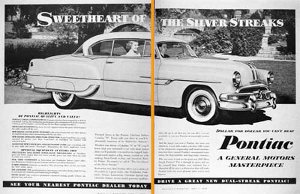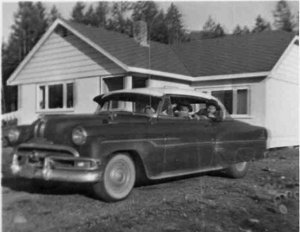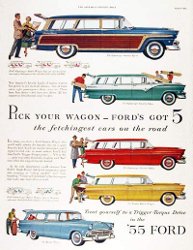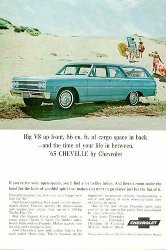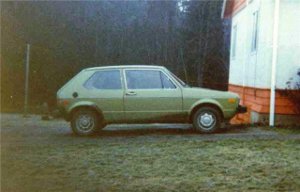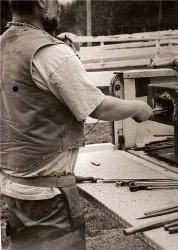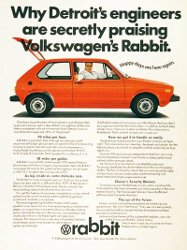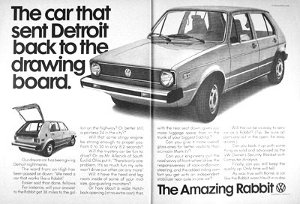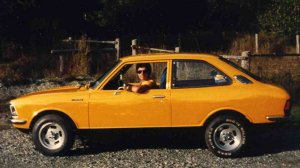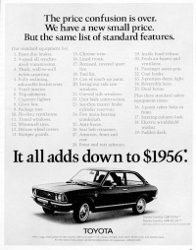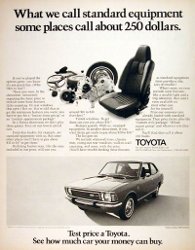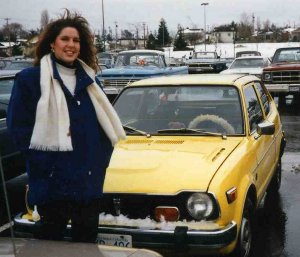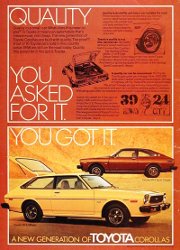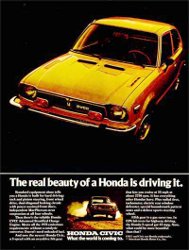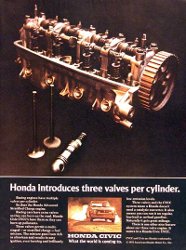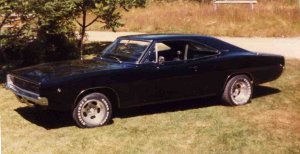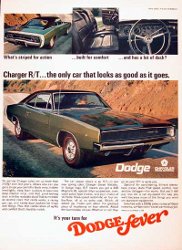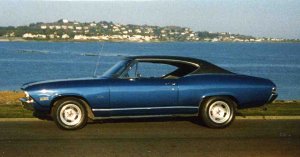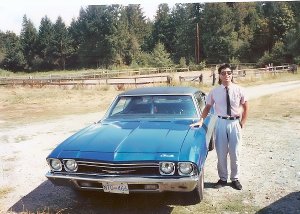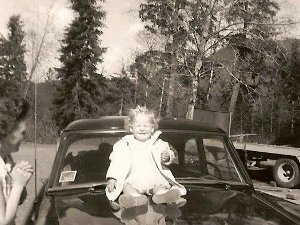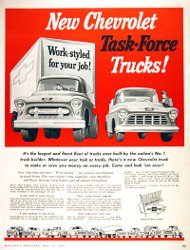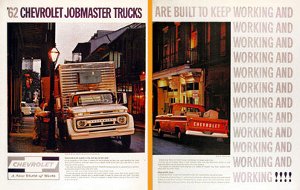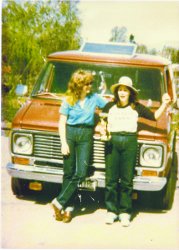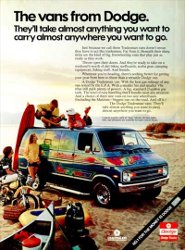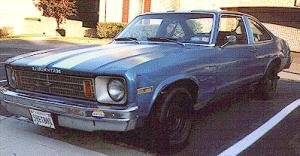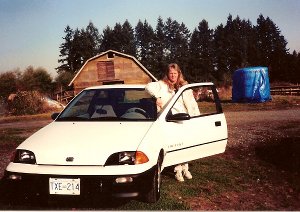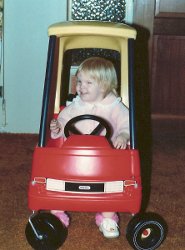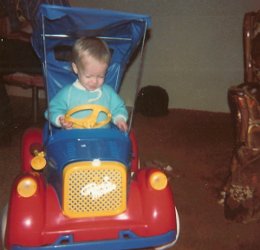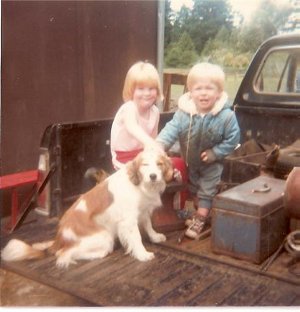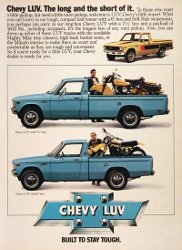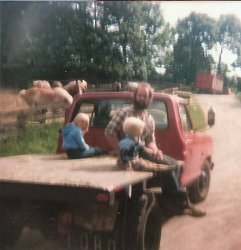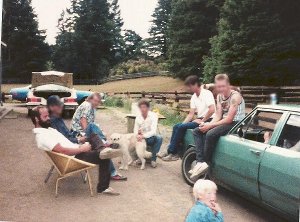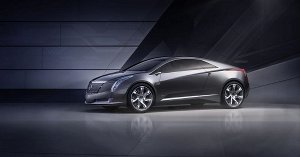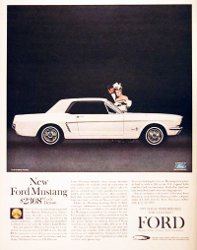Auto-Geneology: Advertising and Our Cars
by Amber Grant
19 March 2009
This paper will be about the cars that members of my family had, why they bought them and what these automobiles meant to them and the rest of our family. The family members I will be talking to will span an age from the horse and buggy to the present day.
The picture below (figure 1) is of my Grandpa Rod Kyle's family, he is the baby peeking out over his father's knee. They lived in Sion, Alberta. Although they bought a Ford Model T they had to keep the horse and buggy because the winters were rough on the roads and the car wouldn't make it to town.
The family boarded the school teacher and she would use the horse and cart to get herself and the children to school (figure 2), she wasn't allowed to drive the car. According to Grandpa the road conditions were a problem for driving the car but the temperamental horse was a problem when driving the buggy. Apparently the horse would go to school and home for the teacher but not detour to town for her. “Just pulled the cart the way it wanted to go, you didn't have to worry about that with the car”.1
So why did they buy a Model T if the roads weren't good enough to drive on most of the time? Grandpa's family were reading about all the different conversion kits that they could get for the Model T. The car became a great help with the Farm work.2 The photo below is from The Henry Ford Museum, shown in New York Times.3 A few people in Grandpa's community had the Model T and bought conversion kits for them so they could make money or trade labor in the summer and fall for harvesting.
The next picture (figure 3) is one of my Grandma Joan and her first husband Fred Burritt. After they were married in 1952 Grandma and Grandpa bought this used car in Vancouver for about $500.00.
Grandpa bought this car because it was a smaller car than most of the other models out at that time and he thought it would be easier for grandma to learn how to drive on it.4 My Grandma never drove it, and didn't learn to drive until her fourth child (Susan) was in kindergarten. There were plenty of ads that made it seem like driving a car was becoming easier and easier and a lot of ads were directed at women.
The ad below (figure 4) is not the car that they bought but it does show how “easy” it is to drive, I like that the woman driving is wearing high heels because it has “tip toe brakes”.5 After their first car they bought a Pontiac and then traded that one for a newer Pontiac. For my grandparents it was much easier to buy used cars, not to mention a lot cheaper, because dealerships were offering used cars as well as new cars. They could also sometimes trade in an older car and put that money towards a newer one.
The next ad (figure 5) is for Chevrolet but Grandma tells me that it was the same idea for most car dealers.6 My grandparents did feel much more secure in their purchase when they bought from a dealership as compared to a private owner because if there was a problem with the car “you had someone to complain to”.7 In 1964/65 Grandma Joan's brother, Roy, started up his own new and used car dealership in Port Alberni and they traded in their cars regularly.8
These are the kinds of ads that were in magazines in the 1950's and my grandparents were definitely a fan of the Pontiac. When they found an ad for this car at a dealership in Vancouver they races over there and traded in the old Pontiac for this one.
This next photo is of (my Dad) Don Burritt and his brother Keith Burritt in the 1953 Pontiac Catalina Chieftain (figure 6). They bought tis car in 1960. According to Grandma Joan the “kids” couldn't have been older than four ( Dad) and six ( Uncle Kieth).10 It was a “classy car and they were very proud of it” outside of their house in Port Alberni.11 “This car was a tank and we could drive it all over the property as long as we went slow!”12
In the photo below (figure 7) we have the “family vacation”. The Burritt family bought a station wagon and went to Penticton in 1969 for some camping. With the edition of my Uncle Joe to the family my grandparents decided that they needed all of the back seat space for the kids and a bigger trunk space.13 Left to right: Grandma Joan, Joe Burritt as a toddler, and Don and Keith Burritt as teens. All of the ads for the Station Wagon have to do with at least one or more of the following three things: 1. Family. 2. Out doors/ vacationing. 3. Fitting the groceries/ other large amounts of things in the trunk space. The Pontiac ad on the left has all three of these things. 14
This ad by Ford, on the left (figure 8), has everything in it except that the outdoors is implied rather than featured.15 The ad by Chevrolet on the right (figure 9) is slightly unusual because the family isn't directly engaged with the car but the message is essentially the same as the others.16
Grandma only liked their wagon as a vacation car, she said that she didn't like how long it took to heat up in the winter.17 The car that grandma did like to drive was this little,1976 green Volkswagen Rabbit (figure 10), parked outside the family home in Port Alberni, below.
This is the car that Grandma learned to drive on. “It was small and easy to maneuver, and it warmed up nice and fast. The Rabbit was the best car we ever had for gas mileage too.”18 This was also the car that my Uncle Joe and Aunt Sue learned to drive on.19
But the greatest story about this car is that my dad used this car for his business. My dad is a Farrier, meaning he puts shoes on horses, so Grandpa Fred used to drive dad to farms with his anvil, forge and other tools in the trunk. Dad would haul the tools out and then cram them back in when he was done and then off to the next farm.20 The picture on the left (figure 11) shows my dad using some of the tools that my he would've had packed into the Rabbit. These tools now take up the entire box of his big 1999 Ford F150, he's not sure how the tools ever fit into the car but they did.
A lot of the ads for the Volkswagen Rabbit are about being superior to the cars made in Detroit. The ad on the left (figure 12) is from 1975 and boasts 38miles per gallon.21 The ad on the right (figure 13), from 1976 claims that Detroit has to go “back to the drawing board.22 The ads are right in a way because my grandparents, like many people, were concerned with gas mileage/ fuel economy.23 But the real ad for this car should have featured the back breaking work my dad used it for because according to dad this car outlasted a few of the pick-up trucks he owned later.24
In the picture on the left is my Uncle Joe Burritt in his 1972 Toyota Corolla (figure 14), his very first car. He built it out of two Corollas and had it painted "Corvette Yellow" with a black stripe on the bottom.25 The main body of the car he got from his Uncle Roy's dealership for $100.00 and the other parts came from a scrap yard out on Beaver Creek Rd.26 Uncle Joe wanted to “stand out” from the rest of the kids in high school in 1984 at age 17 so he chose yellow.27
In my observation all of the ads for the Corolla have to do with getting more features included in the sale price of the car (figure 15 and figure 16)). But Corolla wasn't the only car brand that was making the “more for less” claim. The most important features seem to be gas mileage, cutting down pollution and the low cost to buy a car. The 1974 Subaru GL Coupe ad mentions that it got 33.48 miles to the gallon.30 Ford had the Pinto at 34 miles per gallon (31) and in the 1977 ad for the Chevrolet Chevette it claims 43MPG.32 Mom learned to drive on her mom's car which was a white 1976 Toyota Corolla stick shift. “Had up to eight people in there at one time, don't tell anybody.”33 “Friday nights everyone chipped in for gas. No one rode for free, but it was fine because it was really cheap to fill. Cheap entertainment.”34 We didn't have any pictures of this fabled car but I did find an ad for them.35 According to this ad the Toyota Corolla is “inexpensive not cheap”.36
And below is a picture of my Uncle Joe's wife, Ineke Burritt, when she was 18 years old with her 1975 Honda Civic (figure 17). She bought this car from her older sister in 1991.37 Ineke was standing in the parking lot at Tillicum Mall in Victoria, waiting for her girlfriends.38 This was Ineke's first car. I think it's great that Uncle Joe and Aunt Ineke both had a little yellow, gas saver for their first car. These were also the cars that became affordable as used cars to the youth of the late 80's/ early 90's.
The reason for the concern with gas mileage in the 70's, and therefore the change in car manufacturing,was the raise in gas prices as previously discussed in his paper concerning the Rabbit car purchase.39 But Ford and other American companies started making their own brands of gas saving cars, so why did so many of my family members buy imported cars instead? The general consensus of those interviewed for this paper seem to agree that it was the price, and availability of second hand cars (figure 18 and figure 19).40
While my Aunt went on to buy more small cars, like her 1980 Dodge Omni featured below, Uncle Joe changed his auto choices to the classic high powered gas guzzlers from the 60's. The below ad says that it has extra valves to “burn up pollutants” (figure 20).41 Uncle Joe was/is a big fan of the “muscle car”and his second car was a 1968 Dodge Charger. He said that “the Charger had a big 440 cubic inch V8 and had lots of power, but it sure went through the gas”.42 He always had a “thing” for classic muscle cars “because they're good looking and fast.”43 Attracting “chicks” was a bonus.44
The picture to the right is of Uncle Joe's Charger (figure 21) which he bought in 1986 after starting his mill job.45 Below is the type of advertising that they came up with for the Charger in 1968 (figure 22), before my uncle was even born.46 I like the part in this ad where it says it has “lots of dash” and “Dodge fever” like it's contagious.
Uncle Joe's third car was the blue/black 1968 Chevelle Malibu in the photo below (figure 23).
This was my favorite car, I had it in a number of car shows and cruises. It also drove me to many local drag races, as well as down to the Seattle International Raceway. I sure miss this car and hope to maybe own another one.47
This picture of my uncle ( or 'Joe Cool' according to my mom) was taken in 1990 at age 23, in front of my parent's house in Duncan (figure 24). I remember him being very proud of this car and since he was a bachelor he had lots of money to spend on the upkeep of this car. I also remember that if my brother and I rode in the car with him we were not allowed any food or drink. I couldn't find any old ads for this car but during the 80's my uncle was completely immersed in the muscle car culture.
Below is a picture of my mom at 18 months ( back of the picture just says “Maida 18months) sitting on her uncle's car with her mom on the left (figure 25). While mom doesn't know what kind of car it was, she does remember that her uncle was considered a “city boy” because he drove a car instead of a truck.48 Her family was a family of loggers so trucks were a must.49 “Real men drive Tucks” my mom quotes her father to me.50 The truck ads I came across seem to support this line of thinking because I couldn't find a single ad for a 50's truck where a woman was driving.
Chevrolet marketed to working men brilliantly, with this ad on the left, saying “Whatever your task or trade, there's a new Chevrolet truck to make or save you money on every job (figure 26).”51 And the ad below, right (52 ) shows an example of exactly what my grandpa Rocky would have expected/desired of his trucks (figure 27).53 My mom's family never owned a car until my Grandma and Grandpa got divorced. After the divorce was when my Grandma bought the 1976 Toyota Corolla.54 The “real freedom” of using a car to travel came when my mom's best friend bought a van.55
This is a picture of my mom, Maida Burritt, and her best friend, Donna May (figure 28(. They were 20 years old in 1979, and had just finished a Van rally. Donna is holding the trophy for coming in dead last. According to my mom “the trophy for coming in last was almost as nice as the trophy for coming in first”.56 This took place in Burnaby as part of the Van. Isle. Vans club's annual rally to which Donna was a member (this club no longer exists).57
This ad from Dodge shows the marketing strategy that worked on young people (figure 29), it's all about the freedom to go where ever they want and have a traveling place to hang out at.58 Most of the van ads I looked at had a co-ed theme to them as well as freedom.
My mom didn't own her own car until after she was married and they could afford a second car. My parents bought a Chevy Nova 4 door from Uncle Roy's car dealership in Port Alberni (figure 30).60 I remember this car as being very big and spacious. On long trips my brother and I could sleep on the back seat. They had the racing stripes painted over (much to Uncle Joe's dismay) because they really wanted it to be a family car and mom was tired of being pulled over by the police for “speeding although, I'm sure it was the stripes.”61
In 1991 The Nova “gave up the ghost”and my parents bought their first new car, a Metro Geo.62 (figure 31) “They made a car that was as cheap as buying used, so we thought we would just get a new one, maybe it would last longer.”63 But the “little white bullet”, affectionately named by my mother, met with a tragic end in 1998 when my mom got side swiped by a much bigger car.
For my brother and I growing up the car was to us a tool for social gatherings. At an early age we learned that cars meant fun. Pictured below left is a almost 2 year old Amber Grant (me) in my coupe car at Grandma Ethel's house in 1979 (figure 32). Below right is my brother, Lee Burritt in his play car in 1984 age 11months (figure 33).Lee's car was way fancier than mine was because it had pedals and a horn. This picture was taken in the same place as the one of me, note the same orange-red shag carpeting. My brother remembers this little car well because he “felt liberated from the rocking horse that didn't really go anywhere to something with wheels.”64
But besides having an early love of our “cars”, we grew up in the back of my dad's trucks (figure 34). Because my dad ran his business out of the back of his trucks we spent a lot of our time sitting in them. I asked my dad why he made the switch to a truck from a car for working out of because he did work out of the Rabbit. Dad said he made the switch because it was just because it was easier to get at his tools, but mom said that their friends actually made fun of him for being “this great big guy who drove around with these great big tools with no truck to show for it” so I suspect that it was a combination of these two things that made him leave the idea of a car behind.65
While I couldn't find any truck ads that had to do with family, couple activities but no family activities. I I did find lots of ads having to do with loading a lot of heavy stuff in them like this ad (figure 35) for the Chevy LUV.66
The Ford truck featured in the next picture (figure 36) was converted to a flatbed truck by a friend of my parents.67 According to mom it was like driving a tank and burned through the gas like one, so they only used it for driving around the farm and short trips to town. But as a social device at the Tally Ho barn, where my dad worked 90% of the time in the early 80's, it was great. My brother and I had picnics up on the back of the truck. I think the picture on the lower right (figure 37)is the real ad for big old Dodge/ Cadillac cars. They were seats, fridges, bedrooms, closets, tractors and beer coolers. This crew found driving the car secondary to the other uses they had. Most of the people in the picture could hardly afford to put gas in them.
My dad says that he isn't really influenced by auto ads, he just goes with whatever is cheap as long as it can get him from point A to point B.68 My mom says that she would love to have a 2010, 2 door Cadillac Coupe (figure 38) featured in the ad below.69
I am a fan of many cars and I enjoy looking at them, my dream car would be a 1964 Mustang (figure 39) like the one featured in the ad below.71 But I find that the more recent, over sexualized and over masculine ads don't appeal to me enough to make me go out and buy a car. Not to mention the high cost of owning a car these days. I will just have to be happy enough sharing my mom's 1990 ford tempo, not the most exciting car but it gets the job done. Some of my family members have had quite the love affair with the automobile and others use it as a tool while others find it a point of social congregation, but there can be no doubt that our family wouldn't be the same without the automobile.
Endnotes
1 Rod Kyle, personal interview, 1 March 2009
2 Rod Kyle, personal interview, 1 March 2009
3 The New York Times online, picture from The Henry Ford Museum.
http://www.nytimes.com/slideshow/2008/07/20/automobiles/collectibles/0720-MODELT_3.html
4 Joan Kyle, personal interview, 1 March 2009
5 AdClassix, 1949 New Hillman Minx ad, http://adclassix.com/ads/49hillmanminx3.htm
6 Joan Kyle, personal interview, 1 March 2009
7 ibid
8 AdClassix.com, 1954 Chevrolet used car ad. http://www.adclassix.com/a3/54chevroletokusedcars.htm
9 AdClassix.com, Pontiac Catalina Chieftain,1953. http://www.adclassix.com/ads/50pontiacsedan.htm
10 Joan Kyle, personal interview, 1 March 2009
11 Don Burritt, personal interview, 2 March 2009
12 ibid
13 Joan Kyle, personal interview, 1 March 2009
14 AdClassix.com, 1956 Pontiac Strato Streak Station Wagons ad. http://www.adclassix.com/ads2/56pontiacwagonline.htm
15 AdClassix.com, 1955 Ford Station Wagon ad. http://www.adclassix.com/a3/55fordstationwagons.htm
16 John's Old Car and Truck ads, The Chevrolet Chevelle Station Wagon, 1965, http://oldcarandtruckads.com/Chevrolet/
17 Joan Kyle, personal interview, 1 March 2009
18 ibid
19 Joe Burritt, personal interview, 6 February 2009
20 Don Burritt, personal interview, 2 March 2009
21 AdClassix.com, 1975 Volkswagen Rabbit coupe ad. http://www.adclassix.com/ads/75volkswagenrabbit.htm
22 AdClassix.com, 1976 Volkswagen Rabbit ad. http://www.adclassix.com/a3/76vwrabbit2.htm
23 Rudi Volti, Cars and Culture A Life Story of a Technology. ( Johns Hopkins University Press, Baltimore 2006). p.
135,145
24 Don Burritt, personal interview, 2 March 2009
25 Joe Burritt, personal interview, 6 February 2009
26 Ibid
27 Ibid
28 AdClassix.com, 1972 Toyota Corolla ad. http://adclassix.com/ads/72toyotacorolla.htm
29 AdClassix.com, 1972 Toyota Corolla ad. http://adclassix.com/a3/72toyotacorolla1600.html
30 AdClassix.com, 1974 Subaru GL Coupe ad. http://adclassix.com/a4/74subaruglcoupe.html
31 AdClassix.com. 1975 Ford Pinto ad. http://adclassix.com/ads2/75fordpintoline.htm
32 AdClassix.com, 1977 Cevrolet Chevette ad. http://adclassix.com/a5/77chevychevette.html
33 ibid
34 ibid
35 AdClassix.com, 1976 Toyota Corolla http://www.adclassix.com/a3/76toyotacorollasr5.htm
36 Ibid
37 Ineke Burritt, personal interview, 6 February 2009
38 ibid
39 AdClassix.com, 1975 Honda Civic ad. http://adclassix.com/ads/75hondacivic1.htm
40 Joe, Ineke, Maida Burritt, personal interviews, 12 March 2009
41 AdClassix.com 1975 Honda Civic ad. http://adclassix.com/a3/75hondaciviccvcc.html
42 Joe Burritt, personal interview, 6 February 2009
43 ibid
44 ibid
45 Joe Burritt, personal interview, 6 February 2009
46 AdClassix.com, 1968 Dodge Charger R/T http://www.adclassix.com/ads/68dodgechargerrt.htm
47 Joe Burritt, personal interview, 6 February 2009
48 Maida Burritt, personal interview, 22 February 2009
49 ibid
50 ibid
51 AdClassix.com 1955 Chevrolet Truck Fleet ad. http://www.adclassix.com/ads2/55chevtruckfleet.htm
52 AdClassix.com. 1962 Chevrolet Truck ad. http://www.adclassix.com/ads/62chevrolettrucks.htm
53 Maida Burritt, personal interview, 22 February 2009
54 ibid
55 ibid
56 ibid
Bibliography
BOOKS
Volti, Rudi. Cars and Culture A Life Story of a Technology. ( Johns Hopkins University Press, Baltimore 2006). p. 135,145
ELECTRONIC SOURCES
AdClassix, Vintage classic car ads. March 2009.
http://www.adclassix.com/caradsindex.htm
John's Old Car and Truck ads. March 2009
http://oldcarandtruckads.com/Chevrolet/
Planet Automobile, image. March 2009 http://www.planetautomobile.com/wpcontent/uploads/2009/01/cadillac_coupe_gal4.jpg
INTERVIEWS
Burritt, Don. Interviewed by the author, February 22- March 19, 2009
Burritt, Ineke. Interviewed February 6- March 20, 2009
Burritt, Joe. Interviewed by the author, February 6- March 20, 2009
Burritt, Lee. Interviewed by the author, March 19, 2009
Burritt, Maida. Interviewed by the author, February 22- March 19, 2009
Kyle, Joan. Interviewed by the author, March 1, 2009
Kyle, Rod. Interviewed by the author, March 1, 2009
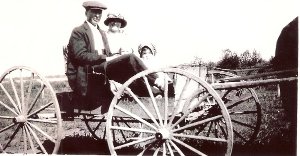
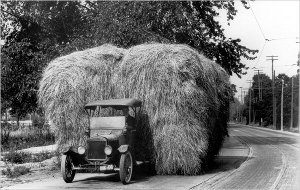
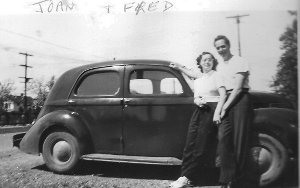
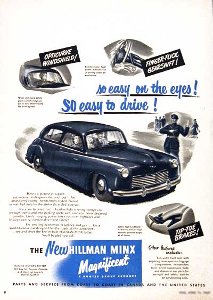
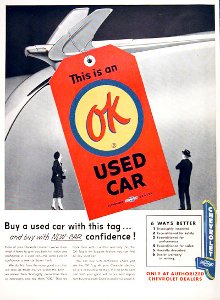 9
9